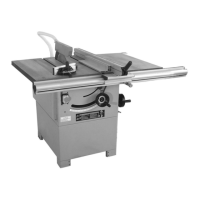26
CARE AND MAINTENANCE….cont
Note: The arbor nut has a left handed thread.
• Remove the outer blade flange and blade from the saw.
• Check that the clamping surfaces are smooth and flat, clean or replace as nec-
essary.
Caution: Do not use cleaning agents (e.g. for removing resin residue) that
could corrode the light metal components of the saw.
• Fit the new saw-blade ensuring that the direction of rotation is correct.
Caution: Do not use:-
⇒ Incorrectly sized blades, either inner or outer diameter.
⇒ Damaged blades, parts could be thrown from the blade by centrifugal force.
• Replace the outer flange.
• Fit and tighten the arbor nut.
Caution: Do not over-tighten the arbor nut, but ensure it is tight enough.
⇒ Do not tighten the arbor nut by “tapping” it with a hammer or similar item.
⇒ Do not forget to remove the arbor wrench and lock bar once the nut has been
tightened.
Setting the distance between the blade and the riving knife:
• Loosen nut (a) of the riving knife bracket.
19
ASSEMBLY INSTRUCTIONS….cont
• Insert the 5 square head bolts into the holes to the rear of the main table and
extension tables so the bolt heads extend out approximately 6 mm.
• Loosely attach a flat washer and a hex nut to each bolt.
• Slide the slot on the rear fence rail over bolts until the rail is in its correct posi-
tion.
• Adjust each bolt to ensure that the rail is as close as possible to the table.
• Push the rear fence rail against table and hand tighten each nut.
Note: The rails have only been secured by hand tightening the nuts at this
point because some adjustment may be required once the rip-fence is fitted.
Fitting the rip-fence:
• Fit the rip fence assembly onto the scale mount.
• If needed, attach the "L" shape extension to the rip fence.
• Slide the rip fence onto the rear and front rails.
• Adjust the height of the rear and front rails to keep the rip fence approximately
1 mm above the table.

